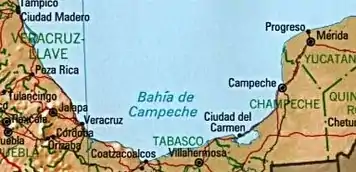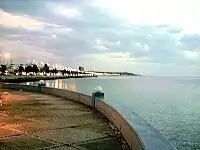Bay of Campeche
The Bay of Campeche (Spanish: Bahía de Campeche), or Campeche Sound, is a bight in the southern area of the Gulf of Mexico. It is surrounded on three sides by the Mexican states of Campeche, Tabasco and Veracruz. The area of the bay is 6,000 square miles (16,000 km2) and maximum depth of the bay is approximately 180 feet (55 m). It was named by Francisco Hernández de Córdoba and Antón de Alaminos during their expedition in 1517.

Oil resources
The Cantarell Complex of five oil fields lies beneath the Bay of Campeche. In 2003, it was the second most productive oil field in the world, then supplying about two thirds of Mexico's crude oil output, but it went into a steep decline soon thereafter.
On June 3, 1979, Ixtoc I, an exploratory oil well located in the bay, suffered a blowout that caused a catastrophic explosion, resulting in what has been ranked as the third largest unintentional oil spill in history.
Climate

During the months of June and July, the Bay of Campeche is considered one of the "hot" breeding spots for Atlantic hurricanes. On the other hand, the bay is also known for being a hurricane "graveyard", with unusually weak steering currents in the area causing hurricanes to slow down and meander, starving themselves (for example, Hurricane Roxanne in 1995). The bay is also considered the eastern border on the main migration routes for birds in the Americas.
Notes
- ^ Hauptmann, David. "Where do hurricanes form and where do they strike?". Archived from the original on 2005-11-20. Retrieved 2006-03-27.
- ^ "Routes of Migration". Migration of Birds. Northern Prairie Wildlife Research Center. Archived from the original on 17 April 2006. Retrieved 2006-03-27.
